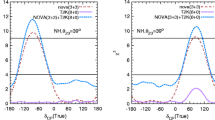Summary
The ordinary law of conservation of lepton number will be assumed. For leptonic weak interactions the usual assumptions are i) the existence of two neutrinos, ii) no neutrino flip, and iii) no neutral current. Since these cannot all be true if the conservation law is to hold, a third neutrino will be introduced as the simplest modification of i). This neutrino is the one from K-μ decay. Under the three-neutrino hypothesis, the discrepancy between the ratioG v/G μ and unity (whereG v is the vector coupling constant for β-decay andG μ is the μ-decay coupling constant) will be explained in a manner consistent with the small branching ratio in the leptonic decay of hyperons. It will be shown that the hypothesis is relatively easy to prove or disprove by experiments on high-energy neutrino reactions, if about 50% or more of the neutrinos are obtained from K-μ decay.
Riassunto
Si presume la solita legge per la conservazione del numero leptonico. Per le interazioni leptoniche deboli le ipotesi usuali sono: 1) l ’esistenza di due neutrini; 2) l ’assenza di flip del neutrino; 3) l ’assenza di correnti neutre. Poichè, se deve esser valida la legge di conservazione, queste ipotesi non possono essere tutte vere, si introduce un terzo neutrino come la modifica più semplice all ’ipotesi 1). Questo neutrino è quello proveniente dal decadimento K-μ. Con l ’ipotesi dei tre neutrini, la discordanza fra il rapportoG v /G μ e l ’unità (in cuiG V è la costante di accoppiamento vettoriale per il decadimento β eG μ è la costante di accoppiamento del decadimento μ) potrà spiegarsi in modo coerente con il piecolo rapporto di branching nel decadimento leptonico degli iperoni. Si mostrerà che l ’ipotesi si può facilmente dimostrare vera o falsa con esperimenti sulle reazioni di neutrini di alta energia, se circa il 50% o più dei neutrini vengono ottenuti da decadimenti K-μ.
Similar content being viewed by others
References
G. Danby, J.-M. Galillard, K. Goulianos, L. M. Lederman, N. Mistry, M. Schwartz andJ. Steinberger:Phys. Rev. Lett.,9, 36 (1962).
G. Feinberg, F. Gursey andA. Pais:Phys. Rev. Lett.,7, 208 (1961);A. Bludman:Phys. Rev.,124, 947 (1961).
M. Taketani andM. Sawamura:Progr. Theor. Phys. (Kyoto),27, 1287 (1962).
C. Iso:Nuovo Cimento,25, 456 (1962).
R. Gatto:Proc. of Annual International Conference on High-Energy Physics at Rochester (1960), p. 609;G. Feinberg andS. Weinberg:Phys. Rev. Lett.,6, 381 (1961).
S. Sakata:Progr. Theor. Phys. (Kyoto),16, 686 (1956).
R. P. Feynman andM. Gell-Mann:Phys. Rev.,109, 193 (1958). See alsoS. S. Gershtein andIa. B. Zel ’dovich:Žurn. Ėksp. Teor. Fiz.,29, 698 (1955).
R. K. Bardin, C. A. Barnes, W. A. Fowler andP. A. Seeger:Phys. Rev.,127, 583 (1962).
M. Goldhaber:Proc. of Annual International Conference on High-Energy Physics at CERN (1958), p. 233. See alsoA. I. Alikhanov:Proc. of Annual International Conference on High-Energy Physics at Kiev (1959).
L. Michel:Proc. Phys. Soc. (London), A63, 514 (1950).
T. D. Lee andC. N. Yang:Phys. Rev.,105, 1671 (1957);A. Salam:Nuovo Cimento,5, 299 (1957);L. Landau:Nucl. Phys.,3, 1271 (1957).
R. J. Plano:Phys. Rev.,119, 1400 (1960);M. M. Block, E. Fiorini, T. Kikuchi, G. Giacomelli andS. Ratti:Proc. of the Annual International Conference on High-Energy Physics at Rochester (1960), p. 533.
L. Okun:Ann. Rew. of Nucl. Sci.,9, 61 (1959).
W. E. Humphrey, J. Kirz, A. H. Rosenfeld, J. Leitner andY. I. Rhee:Phys. Rev. Lett.,6, 478 (1961).
D. Bartlett, S. Devons andA. Sachs:Phys. Rev. Lett.,8, 120 (1962);S. Frankel, J. Halpern, L. Holloway, W. Wales, M. Yearian, O. Chamberlain, A. Lemonick andF. M. Pipkin:Phys. Rev. Lett.,8, 123 (1962);L. Holloway, S. Frankel, W. Frati, J. Halpern, W. Wales, F. W. Betz andO. Chamberlain:Bull. Am. Phys. Soc.,7, 489 (1962).
B. L. Loffe:Proc. of the Annual International Conference on High-Energy Physics at Rochester (1960), p. 561.
M. E. Ebel andF. J. Ernst:Nuovo Cimento,15, 173 (1960).
Author information
Authors and Affiliations
Additional information
Work performed under the auspices of the U.S. Atomic Energy Commission.
Traduzione a cura della Redazione.
Rights and permissions
About this article
Cite this article
Hida, K. Three-neutrino hypothesis. Nuovo Cim 27, 1439–1449 (1963). https://doi.org/10.1007/BF02785638
Received:
Published:
Issue Date:
DOI: https://doi.org/10.1007/BF02785638




